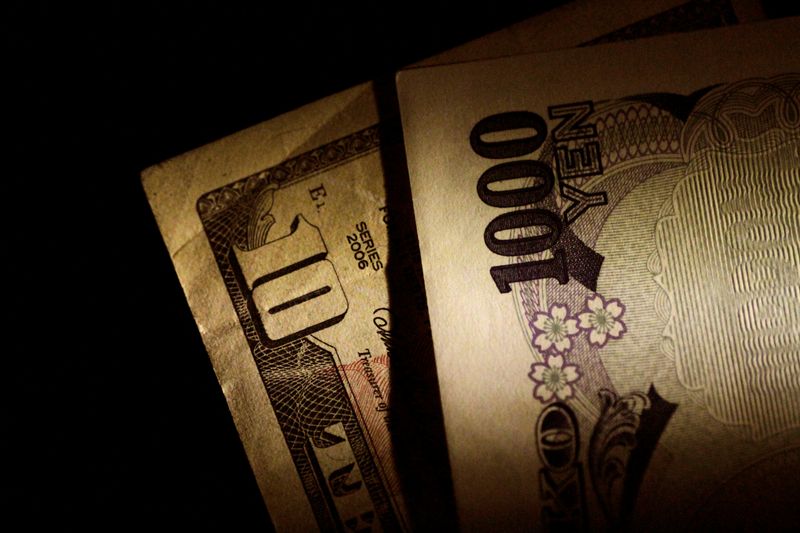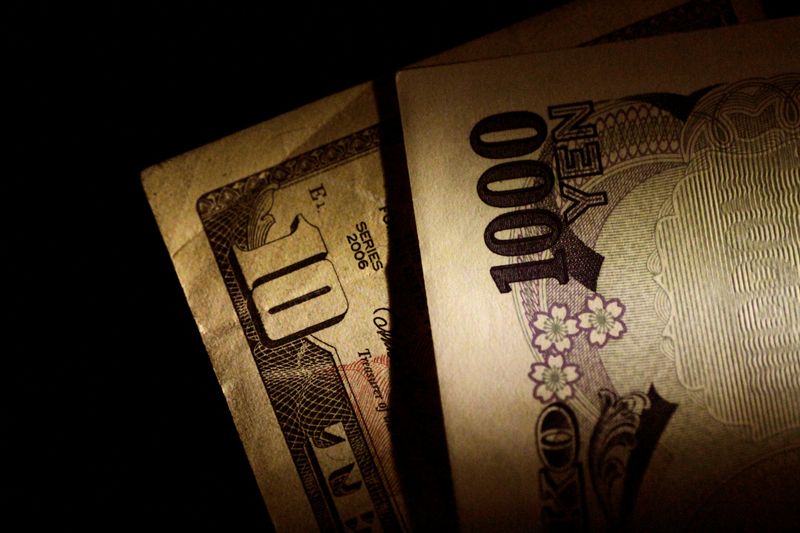
By Gertrude Chavez-Dreyfuss and Amanda Cooper
NEW YORK/LONDON (Reuters) -The yen edged up from a 38-year low against the U.S. dollar on Thursday, helped by softening U.S. economic data, although traders remained on high alert for any signs of Japanese intervention to prop up the currency.
In the broader market, the dollar fell against a basket of currencies, as U.S. Treasury yields slipped following the data.
U.S. reports showed that jobless claims for state unemployment benefits dropped 6,000 to 233,000 for the week ended June 22. However, the number of people receiving benefits after an initial week of aid increased 18,000 to 1.839 million during the week ending June 15.
At the same time, new orders for key U.S.-manufactured capital goods unexpectedly fell in May, suggesting business spending on equipment weakened in the second quarter.
Non-defense capital goods orders excluding aircraft, a closely-watched proxy for business spending plans, dropped 0.6% last month, the data showed. Economists polled by Reuters had forecast core capital goods orders edging up 0.1%.
“This morning’s data deluge helped puncture the ‘U.S. exceptionalism’ trade, knocking the greenback lower,” said Karl Schamotta, chief market strategist, at Corpay in Toronto, referring to the U.S. outperformance with respect to the rest of the world.
“Odds on a cut at the Federal Reserve’s September meeting are firming and yields are cautiously coming down across the curve as market participants position ahead of tomorrow’s personal consumption expenditures release.”
More data showed that economic growth moderated sharply in the first quarter. Gross domestic product increased at a slightly upwardly revised 1.4% annualized rate last quarter, but down from the 3.4% registered in last three months of 2023.
The GDP report also showed weak consumer spending.
YEN WOES
In late morning trading, the yen gained 0.2% against the greenback to 160.555 per dollar, having fallen to a low of 160.88 on Wednesday, its weakest since 1986.
The Japanese currency has fallen some 2% this month and 12% for the year against a resilient dollar, as it continues to be hammered by stark interest rate differentials between the U.S. and Japan. That has encouraged investors to use the yen as funding currency for carry trades.
In a carry trade, an investor borrows in a currency with low interest rates and invests the proceeds in higher-yielding assets.
Still, the yen’s latest slide past the key 160 per dollar level has kept traders nervous over possible intervention from Tokyo, after authorities spent 9.79 trillion yen ($60.94 billion) at the end of April and in early May to push the yen up 5% from its 34-year low of 160.245 then.
“There seems little chance that the Bank of Japan and its allies can shore up the yen without incurring horrendous costs, or jacking up rates to such an extent that they destroy the economy,” Trade Nation senior market analyst David Morrison said.
Analysts said while the risk of intervention has increased, Japanese authorities could be holding out for Friday’s release of the U.S. personal consumption expenditures (PCE) price index before entering the market. Still, any intervention would likely have a limited effect, they said.
In other currencies, sterling rose 0.3% to $1.2651 while the euro rose 0.3% to $1.0710.
The euro is on track to lose roughly 1.4% this month, weighed down by political turmoil in the euro zone in the lead up to France’s snap election set to begin this weekend.
The dollar index fell 0.2% to 105.84, not far from a nearly two-month high of 106.13 on Wednesday.
The Swedish crown weakened after the central bank held its key interest rate at 3.75% on Thursday, as expected, and said if inflation prospects remain the same, the policy rate could be cut two or three times during the second half of the year.
The dollar was last 0.3% higher at 10.608 crowns.
Wednesday was the last day that investors could trade currencies for the quarter, given that spot foreign exchange settlement takes two business days.
Trading of U.S. stocks, however, moved to a shorter settlement cycle last month, known as T+1.
Currency
bid
prices at
27 June
03:23
p.m. GMT
Descripti RIC Last U.S. Pct YTD Pct High Low
on Close Change Bid Bid
Previous
Session
Dollar 105.88 106.05 -0.15% 4.45% 106.08 105.
index 7
Euro/Doll 1.0704 1.0681 0.22% -3.03% $1.0726 $1.0
ar 677
Dollar/Ye 160.65 160.79 -0.09% 13.89% 160.68 160.
n 32
Euro/Yen 1.0704 171.72 0.13% 10.49% 172.16 171.
39
Dollar/Sw 0.8977 0.8975 0.01% 6.64% 0.8981 0.89
iss 59
Sterling/ 1.2646 1.2622 0.21% -0.61% $1.267 $1.0
Dollar 677
Dollar/Ca 1.369 1.3703 -0.08% 3.29% 1.3712 1.36
nadian 76
Aussie/Do 0.6649 0.6648 0.05% -2.46% $0.6673 $0.6
llar 64
Euro/Swis 0.9607 0.9584 0.24% 3.46% 0.962 0.95
s 79
Euro/Ster 0.8461 0.8461 0.01% -2.38% 0.8475 0.84
ling 54
NZ 0.6088 0.6083 0.11% -3.63% $0.6109 0.60
Dollar/Do 69
llar
Dollar/No 10.6552 10.6779 -0.21% 5.13% 10.6923 10.6
rway 32
Euro/Norw 11.4056 11.4066 -0.01% 1.62% 11.418 11.3
ay 778
Dollar/Sw 10.6172 10.5736 0.41% 5.47% 10.6182 10.5
eden 48

Euro/Swed 11.366 11.2899 0.67% 2.16% 11.369 11.2
en 837
This post is originally published on INVESTING.


